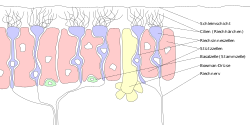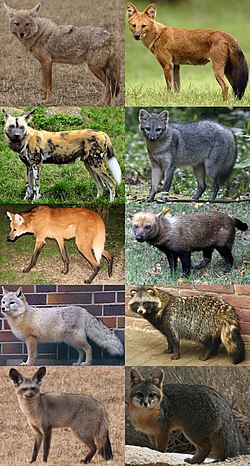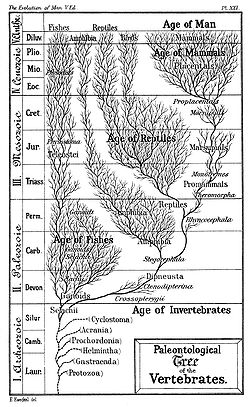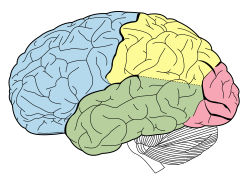similarly to other sensory systems, olfaction has undergone fairly modest changes throughout the evolution of vertebrates. Phylogenetic analyses reveal...
43 KB (5,762 words) - 20:56, 23 May 2025
The sense of smell, or olfaction, is the special sense through which smells (or odors) are perceived. The sense of smell has many functions, including...
62 KB (7,527 words) - 21:28, 11 May 2025
olfactory system, is the sensory system used for the sense of smell (olfaction). Olfaction is one of the special senses directly associated with specific organs...
32 KB (3,761 words) - 16:39, 22 May 2025
1101/022103. {{cite journal}}: Cite journal requires |journal= (help) Wikimedia Commons has media related to Olfactory receptor neurons. Insect olfaction...
11 KB (1,188 words) - 06:57, 8 May 2025
Canidae (redirect from Evolution of canids)
Michigan. Retrieved 13 June 2014. Doty, Richard (2 December 2012). Mammalian Olfaction, Reproductive Processes, and Behavior. Elsevier. ISBN 978-0-323-15450-5...
46 KB (5,073 words) - 00:54, 28 May 2025
timeline of human evolution outlines the major events in the evolutionary lineage of the modern human species, Homo sapiens, throughout the history of life...
88 KB (3,508 words) - 15:09, 29 May 2025
Turtle (redirect from Symposium on Turtle Evolution)
which were detected by olfaction in the nose. Such signals could be used in navigation. The rigid shell of turtles is not capable of expanding and making...
127 KB (13,174 words) - 16:54, 22 May 2025
Dromaeosauridae (category CS1 maint: DOI inactive as of November 2024)
Witmer, Lawrence M. (13 April 2011). "Evolution of olfaction in non-avian theropod dinosaurs and birds". Proceedings of the Royal Society B: Biological Sciences...
95 KB (9,447 words) - 22:03, 22 May 2025
Arthropod (redirect from Evolution of arthropods)
(December 2007). "The Role of Behavior in the Evolution of Spiders, Silks, and Webs" (PDF). Annual Review of Ecology, Evolution, and Systematics. 38: 819–846...
141 KB (13,650 words) - 20:01, 29 May 2025
Lizard (redirect from Evolution of lizards)
Lizards make use of their senses of sight, touch, olfaction and hearing like other vertebrates. The balance of these varies with the habitat of different species;...
70 KB (6,764 words) - 18:52, 23 May 2025
Olfactory receptor (redirect from Evolution of olfactory receptors)
doesn't adequately reconstitute the complex nature of olfaction...". In response, the authors of the second study state "Embryonic kidney cells are not...
36 KB (4,267 words) - 20:29, 23 April 2025
Animal communication (redirect from Evolution of animal communication)
of the species as a whole, but this would require a process of group selection which is believed to be mathematically impossible in the evolution of sexually...
85 KB (9,950 words) - 16:57, 22 May 2025
Hesperornis (category Late Cretaceous birds of North America)
Witmer, Lawrence M. (13 April 2011). "Evolution of olfaction in non-avian theropod dinosaurs and birds". Proceedings of the Royal Society B: Biological Sciences...
28 KB (3,169 words) - 04:39, 25 May 2025
The evolution of nervous systems dates back to the first development of nervous systems in animals (or metazoans). Neurons developed as specialized electrical...
23 KB (2,628 words) - 18:52, 6 April 2025
Hippocampus (redirect from Evolution of the hippocampus)
been largely associated with olfaction. Many studies later culminating in work by Papez, and MacLean, the involvement of other interacting brain regions...
139 KB (16,119 words) - 00:45, 28 May 2025
The evolution of tetrapods began about 400 million years ago in the Devonian Period with the earliest tetrapods evolved from lobe-finned fishes. Tetrapods...
67 KB (7,969 words) - 17:14, 23 May 2025
Bear (redirect from Evolution of bears)
intense. With their acute sense of smell, bears can locate carcasses from several kilometres away. They use olfaction to locate other foods, encounter...
107 KB (10,961 words) - 16:01, 4 May 2025
Pheromone (redirect from Evolution of pheromones)
only olfactory receptor that is responsible for trimethylamine olfaction in humans. As of December 2015,[update] hTAAR5-mediated trimethylamine aversion...
54 KB (6,318 words) - 04:39, 19 May 2025
PMID 23073637. S2CID 17489247. Potier, Simon (2020). "Olfaction in raptors". Zoological Journal of the Linnean Society. 189 (3): 713–721. doi:10.1093/zoolinnean/zlz121...
49 KB (5,081 words) - 14:45, 23 May 2025
Cerebrum (redirect from Cerebrum of brain)
in a loss of olfaction (the sense of smell). Speech and language are mainly attributed to parts of the cerebral cortex. Motor portions of language are...
16 KB (1,780 words) - 08:14, 20 April 2025
Olfactory memory (redirect from Evolution of olfactory memory)
recognition of the mother by her offspring. Throughout evolutionary history, olfaction has served various purposes related to the survival of the species...
42 KB (5,325 words) - 16:58, 24 April 2025
Shark (redirect from Evolution of sharks)
(Chondrichthyes, Elasmobranchii) and their bearing on the evolution of dental enameloid in Neoselachii". Journal of Vertebrate Paleontology. 32 (2): 255–266. Bibcode:2012JVPal...
145 KB (14,427 words) - 15:30, 29 May 2025
Olfactory bulb (section Evolution)
bulbus olfactorius) is a neural structure of the vertebrate forebrain involved in olfaction, the sense of smell. It sends olfactory information to be...
39 KB (4,614 words) - 22:40, 23 May 2025
Limbic system (redirect from Evolution of the limbic system)
variety of functions including emotion, behavior, long-term memory, and olfaction. The limbic system is involved in lower order emotional processing of input...
39 KB (4,811 words) - 11:08, 26 May 2025
Strepsirrhini (redirect from Reproductive physiology of strepsirrhine primates)
understanding of mammalian evolution and the evolution of strepsirrhine traits, such as their reliance on smell (olfaction), characteristics of their skeletal...
83 KB (8,591 words) - 19:39, 2 April 2025
Neurogastronomy (category Olfaction)
making. Areas of interest include how olfaction contributes to flavor, food addiction and obesity, taste preferences, and the linguistics of communicating...
11 KB (1,165 words) - 19:13, 5 December 2024
Johnjoe McFadden (category Academics of the University of Surrey)
recent findings in photosynthesis, enzyme catalysis, avian navigation, olfaction, mutation and neurobiology. The book received positive reviews, for example:...
8 KB (729 words) - 15:09, 7 October 2024
Olfactic communication (category Olfaction)
become a platform of nonverbal communication. Smell also has a significant influence on social interactions. Through their branch of olfaction research, the...
32 KB (3,901 words) - 03:18, 14 April 2025
Olfactory trigone (category Wikipedia articles incorporating text from the 20th edition of Gray's Anatomy (1918))
small triangular area in front of the anterior perforated substance. Its apex, directed forward, occupies the posterior part of the olfactory sulcus, and is...
1 KB (109 words) - 06:42, 28 February 2022
Copulation (zoology) (redirect from Evolution of copulation control in hominids)
only olfactory receptor that is responsible for trimethylamine olfaction in humans. As of December 2015,[update] hTAAR5-mediated trimethylamine aversion...
31 KB (3,208 words) - 07:42, 25 May 2025

























